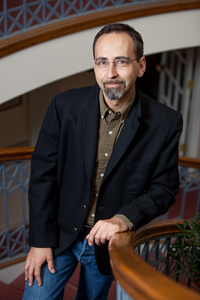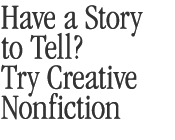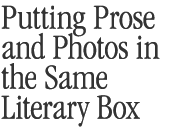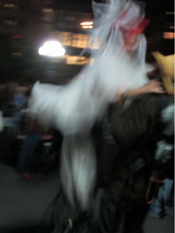
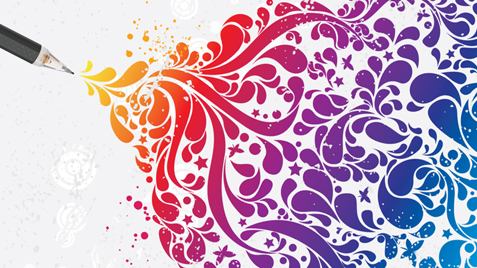
/ Published June 5, 2012
If you want to understand the power of the creative nonfiction genre, consider spending a few days in a lab with a scientist and then writing about it, says Russ Rymer, acclaimed editor and writer and current writer-in-residence at Smith.
Rymer insists that preparing for the advanced nonfiction-writing seminar he taught in the spring semester involved lurking around the science buildings and accosting strangers, as he sought to recruit scientists willing to take his writing students into the lab. “I spent a week hanging around that end of campus, and every time somebody walked by me I grabbed them by the coat lapel and said, ‘Do you work here? Would you like your life to get more complicated?’”
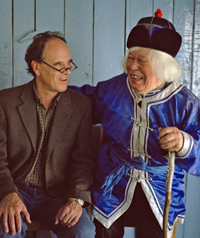
Russ Rymer interviews a shaman in Kyzyl, Tuva, a Russian Republic in Siberia, for a story in the July issue of National Geographic. Photo by Lynn Johnson.
Whether it happened exactly this way or not, the image befits the ethos that the current Joan Leiman Jacobson Nonfiction Writer-in-Residence at Smith College has tried to instill in students: going after a story by getting up close to the subject. Through his trolling and with the generous assistance of senior science faculty, Rymer found geologists, physicists and biologists willing to take an aspiring writer under their wings for a sustained period to observe how science unfolds and to describe the wonder that occurs even between the rare eureka moments.
Rymer’s presence on campus is in keeping with a longstanding effort by Julio Alves, director of the Jacobson Center for Writing, Teaching and Learning, to give the creative nonfiction genre a greater prominence at Smith. “I have been interested in this very deeply,” he says. The big idea is to use the techniques of literature to tell stories based strictly in fact. The writer employs such standard elements of fiction as suspense, character development, dialogue, foreshadowing, conflict, tension, mystery, surprise, vivid description, plot and a strong narrative voice.
“Creative nonfiction provides a fresh way to look at old subjects in an academic setting,” says Alves. “It opens the door for students to express themselves in a more liberated way.” The objective of creative nonfiction is similar to the mission of the liberal arts, he explains, as both seek to “communicate complex information to a mass audience.” He believes it is also “a tool [students] should take with them to engage with the world and to continue to write, no matter what their profession.”
He traces the form to McClure’s Magazine, the early 20th-century monthly that pioneered “muckraking” as integral to the journalist’s craft. Recognition of the value of using literary devices in what is alternatively called “narrative nonfiction” or “literary nonfiction” came with the 1973 publication of The New Journalism, a compendium edited by Tom Wolfe and E. W. Johnson. The book pulled together examples from writers like Norman Mailer, Hunter S. Thompson, Joan Didion and George Plimpton.
Truman Capote’s In Cold Blood, first published in 1965 as a four-part series in The New Yorker magazine, exemplifies for Alves the awakening of the genre. Prompted by a 300-word news account of a family that was murdered in their Kansas home, the author went on a six-year odyssey not only to learn everything he could about the victims, the community, the investigators and—before they were executed—the perpetrators, but to weave the strands of his scrupulously factual reporting into a story that reads like a novel.
Alves is incorporating this approach, which marries storytelling and academic rigor, into the introductory-level writing courses at Smith. He created an intersession course called Popular Nonfiction, taught by working writers from the community, and during the academic year he hosts a Working Writers series where students can meet practitioners in an intimate setting. Alves’ other new course ENG 135 Introduction to Creative Nonfiction, offered this year through the English department, featured two sections: writing about sports and writing about the environment. Future offerings may include food writing, biography and travel.
Those who want to go further can use pieces they generate in English 135 as part of the portfolio required for admission to courses like those taught by Rymer, who has had a career traipsing the world as a freelancer on assignment for magazines including The New Yorker and National Geographic (which is publishing his story on endangered languages in July). His residency at Smith continues through the 2012–13 academic year. His successor in the endowed chair will be Dava Sobel, author of Galileo’s Daughter, the highly acclaimed historical memoir using letters the astronomer received from his oldest child, a cloistered nun, as a lens through which to apprehend the heresies he was accused of.
But can creative nonfiction writing make sense of science? During a spring semester lunchtime lecture, Rymer raised the question of whether creativity and nonfiction are compatible in writing about science: “Why subvert reason with aesthetics?” He asked students to contemplate that question before turning them loose in labs with the scientists he jokingly refers to as “these poor people who have never done us any harm.”
A student of writing can learn much from the scientist’s discipline. “The hardest part of writing is not expression, it is observation,” according to Rymer. “Just as the first task of drawing is not training the hand, it is training the eye.”
To be a good writer “you need to go slow and get your face right down in the dirt,” says Rymer. “Scientists are used to doing that because that’s how they work.”
Another benefit of connecting students to working scientists, says Rymer, is that it gives students a “good, meaty subject that is outside of themselves” to observe and write about. He was especially proud of a student who wrote a powerful piece about a geologist who, in the lab, puts rocks under pressures similar to those found in subduction zones, a mile or two beneath the earth’s crust. It is a time-consuming process that offers little in the way of scientific flash. At the end of the student piece, she describes the moment when the equipment is opened and a hand reaches in to retrieve the rock specimen, but the writer never reveals what, if anything, was the concrete result of the lab experiment.
“I was very pleased that she stuck to describing just the process to the very end and did not drift off to revealing what all this meant,” says Rymer. “I didn’t want this to be a piece about the answer to the question, but one that showed simply the observation. I was thrilled.”













